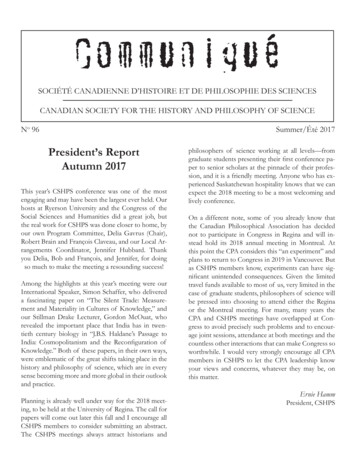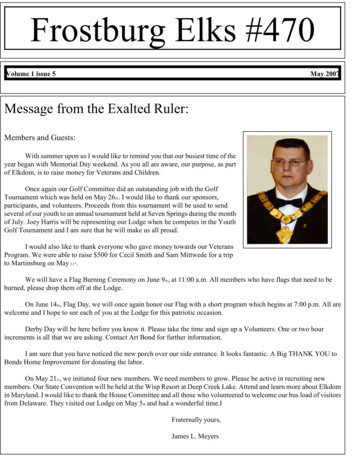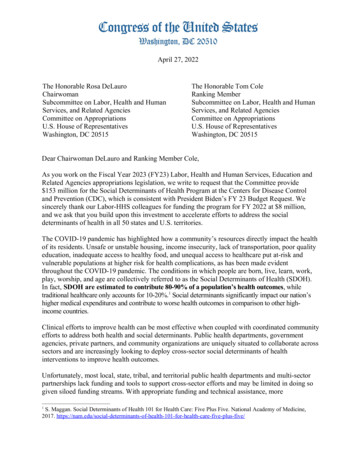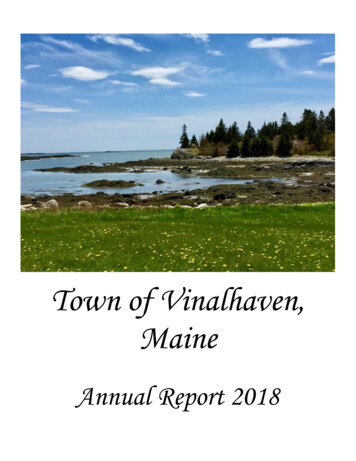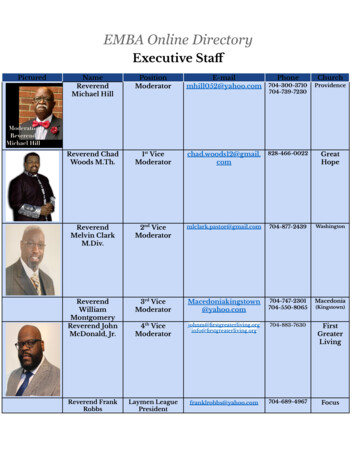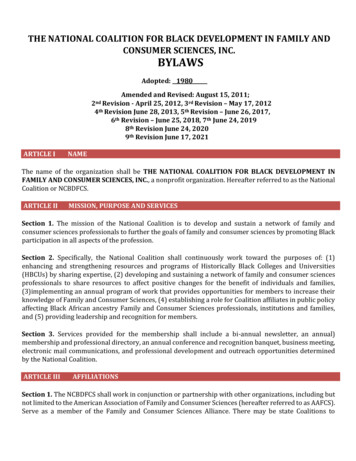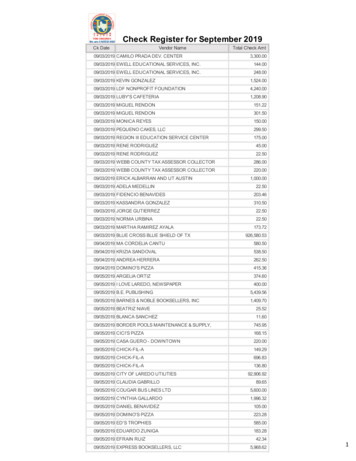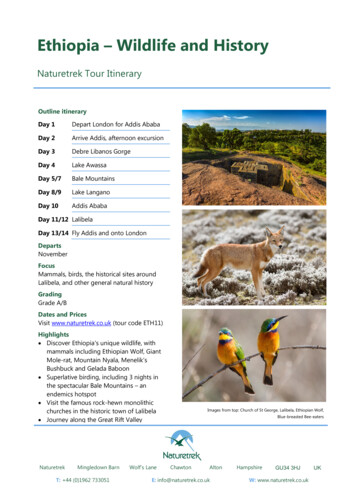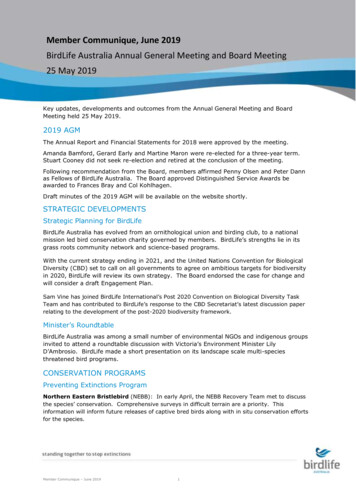
Transcription
Member Communique, June 2019BirdLife Australia Annual General Meeting and Board Meeting25 May 2019Key updates, developments and outcomes from the Annual General Meeting and BoardMeeting held 25 May 2019.2019 AGMThe Annual Report and Financial Statements for 2018 were approved by the meeting.Amanda Bamford, Gerard Early and Martine Maron were re-elected for a three-year term.Stuart Cooney did not seek re-election and retired at the conclusion of the meeting.Following recommendation from the Board, members affirmed Penny Olsen and Peter Dannas Fellows of BirdLife Australia. The Board approved Distinguished Service Awards beawarded to Frances Bray and Col Kohlhagen.Draft minutes of the 2019 AGM will be available on the website shortly.STRATEGIC DEVELOPMENTSStrategic Planning for BirdLifeBirdLife Australia has evolved from an ornithological union and birding club, to a nationalmission led bird conservation charity governed by members. BirdLife’s strengths lie in itsgrass roots community network and science-based programs.With the current strategy ending in 2021, and the United Nations Convention for BiologicalDiversity (CBD) set to call on all governments to agree on ambitious targets for biodiversityin 2020, BirdLife will review its own strategy. The Board endorsed the case for change andwill consider a draft Engagement Plan.Sam Vine has joined BirdLife International’s Post 2020 Convention on Biological Diversity TaskTeam and has contributed to BirdLife’s response to the CBD Secretariat’s latest discussion paperrelating to the development of the post-2020 biodiversity framework.Minister’s RoundtableBirdLife Australia was among a small number of environmental NGOs and indigenous groupsinvited to attend a roundtable discussion with Victoria’s Environment Minister LilyD’Ambrosio. BirdLife made a short presentation on its landscape scale multi-speciesthreatened bird programs.CONSERVATION PROGRAMSPreventing Extinctions ProgramNorthern Eastern Bristlebird (NEBB): In early April, the NEBB Recovery Team met to discussthe species’ conservation. Comprehensive surveys in difficult terrain are a priority. Thisinformation will inform future releases of captive bred birds along with in situ conservation effortsfor the species.Member Communique – June 20191
King Island Scrubtit and King Island Brown Thornbill:BirdLife and Cradle Coast NRM jointly managed ANU’scomprehensive surveys for King Island Scrubtit and King IslandBrown Thornbill. The survey team found both birds duringMarch surveys.The report, currently being written, will be used to inform aBirdLife/King Island NRM Group supported Conservation ActionPlanning workshop.Western Bristlebird (WB) and Western Ground Parrot(WGP): The Preventing Extinctions team and WA program areworking with the South Coast Threatened Bird Recovery Team to secure funding for monitoring inthe Fitzgerald River National Park (FRNP) for both species using acoustic monitoring units. Thepark has not been monitored for many years because of tight access restrictions to limit thespread of phytophthora.National Laws and PolicyAn Invasive Species Council workshop with key NGOs, scientists and governments met to design amore effective key threatening process and threat abatement process under federal laws. Itlooked at ways to make the current system work better and options that involved approaches thatrequired a rewrite of the laws.Conservation CampaignsA series of emails were sent to supporters, with the primary ask switching from ‘share yourstory’ to ‘email your candidates’ in the run-up to the federal election. Four ‘town hall’ eventswere held around the country, identifying emerging advocates, as part of the nature lawscampaign. Key highlights included: more than 289 stories shared via platform and email,including Australian singer-songwriter, Paul Kelly; 4,291 email your MP / candidatesubmissions, and 383,189 people engaged via social media.Coastal Birds ProgramMigratory ShorebirdsThree stakeholder CAP workshops were held to form the basis of Coorong and South EastShorebird Alliance Migratory Shorebird site action plans focused on local priorities forshorebird conservation. The first of these plans has been collated and will enablestakeholders to apply the MS CAP at a localised scale.The Floating roost trial supported byWoodside Energy and BirdLife donors,aims to provide low cost, low impact,adaptable artificial roosts, where a lack ofhigh tide roosts are a limiting factor toshorebird condition. The trial andassociated studies were successfullydeployed at Melbourne Water’s WesternTreatment Plant and in the HunterEstuary. A third trial site in the GeumEstuary was installed in mid-April 2019.Project -trial/Member Communique – June 20192
The Directory of Important Habitat for Migratory Shorebirds will be launched in late 2019. Anadditional project will analyse data to prioritise Eastern Curlew habitat for protection andmanagement and review the efficacy of artificial roosts for the species.The Campaigns Team supported BirdLife SouthernQueensland and community groups to hold a preelection ‘line in the mud’ event againstinappropriate development at Toondah Harbour.Local candidates were invited. This was a nonpartisan event calling on people to think carefullyabout ‘voting for birds’ in this election. More than500 people attended, with good local TV and radiomedia coverage. ‘Toondah: Save the Bay’ signsand a billboard on one of the major local roadshave been installed.BirdLife Australia continues to work with theVictorian National Parks Association on protectionof the Moolap site and will respond to the FinalManagement Plan once released.Beach-nesting BirdsThe multi-state Hooded Plover Project continues with staff committed to coordinating anddelivering repeated monitoring of 67 sites and implementing on-ground management ornegotiating policy change at these sites to mitigate threats.BirdLife piloted new ‘bird safe’ pit-falling techniques for a project to evaluate the impact ofcompaction by horses on beaches. An Honours student has been recruited, supported byDeakin University supervisors Mike Weston and Nick Porch, together with BirdLife’sGrainne Maguire.The Coastal Ambassador Youth Program encourages young people aged 10-17 to apply for atwo-day coastal education course covering topics on BnB, migratory shorebirds, turtles,plastics and other key coastal conservation issues. A Facebook post advertising the eventreached 7,543 people and had 307 actions. Participants were trained as future ambassadorsto help spread awareness among their peers.The 7th National Beach-nesting Birds Conference was scheduled for 24-26 May with 152registered attendees from across Australia, including volunteers, land managers, coastalpractitioners and researchers. Several NRMs sponsored attendees as they see the event asan opportunity to promote the collaborative nature and the landscape scale of the project.BirdLife Australia continues to liaise with Victorian National Parks Association andEnvironment Justice Australia to stop commercial racehorse training in the Belfast CoastalReserve under the EPBC Act.Member Communique – June 20193
Woodland Birds ProgramRegional workshops were rolled out to putthe Woodland Birds CAP back tostakeholders for engagement, buy in andrevision. The workshop at Clarkesdaleidentified an opportunity for the reserve tobe a hub for connectivity conservation.Most of the CAP’s focal species for the areaare present at the reserve.A project inception meeting was held withANU for new mainland Swift Parrotmonitoring contracts. Ground-truthing fornew monitoring sites will commence fromMay/June. The National Recovery Plan isalso out for public comment.Site assessments for the 2019 Regent Honeyeater captive release were undertaken in lateFebruary; with two sites standing out as potentially suitable for captive release. Furthermonitoring will narrow this down over the coming months.An internal campaign strategy will soon be finalised to protect key Regent Honeyeater sites.The Warragamba EIS report is expected in mid-2019 for public comment. A petition withvideo was launched in response to yet another ‘proposal’ to develop critical breeding habitatin the Hunter Economic Zone. The issue received significant media attention.A face-to-face steering committee meeting for the Mallee CAP was held in Adelaide, bringingtogether key stakeholders for an annual review. Priorities were identified for the next 12months. Gluepot is working with the CEO on a proposal to position the reserve at the heartof this program.Key Biodiversity Area (KBA) ProgramThe National KBA Coordination group will meet to explore alignment with proposed ambitioustargets for all governments to protect 30% of its land and oceans for nature by 2030 as partof the UN’s post 2020 CBD strategy.Former IBAs and Alliance for Zero Extinction sites in Australia have now been reconciledresulting in 333 KBAs to date including those for critically endangered, plants, crustaceans,frogs etc. Plans are underway to explore the Great Western Woodlands as one of the firstKBAs globally to be declared under Criterion C intact ecosystems, ie ‘Wilderness’.In 2018, health checks were submitted for 91 KBAs. This puts Australia in the top threeBirdLife partners globally for Pressure, State, Response monitoring of KBAs/IBAs. VolunteerKBA Guardians are conducting diverse conservation actions from bird monitoring, toeducation, signage, lobbying of NRM and parks staff to advocacy and contribution to otherBirdLife programs.Over 2,000 shared sites for standardised birdata surveys have been established in KBAs.Member Communique – June 20194
SCIENCE & RESEARCH PROGRAMSMonitoring ProgramBirdataThe next phase of Birdata redevelopment is nearing completion – with works largelyfocussing on improving user interface functionality and engagement in the Explore andMyData sections, including raw reporting rates for individual species at different spatialscales. Birdata homepage (re)design drafts have recently been drawn up. Changes includemore attractive, interactive user experience, personalised homepages with additional statsand a much more versatile informative blog/news item section. Subsequent Birdatadevelopment will focus on more versatile use of data by individuals, an improved Shared Sitesection user experience and better visual access to monitoring network data such as S2020.A new feature on the Birdata app for the Beach-nesting Birds Program is currently beingtested by staff. This will make a significant difference to the biennial census of beach-nestingbirds (in terms of data capture, reporting turnaround time, better use of staff and volunteerresources) and is flexible so as to allow regular fixed route searches on beaches at any time.The Australasian Seabird Group has drafted a proposal to add seabird beach wreck surveysto Birdata.State of Australia’s Birds (SoAB) reportingThe Threatened Bird Index (TBX) was launched by the Threatened Species Commissioner atthe Ecological Society of Australia’s conference in 2018. The project is now working onthreatened plants and mammals. A short introductory video animation and the webvisualisation tool is available online at: https://tsx.org.au/tsx.In order to influence policy and drive change, bird indices need to be institutionalised intoState of the Environment reporting at state, federal and regional (NRM) levels.SOAB 2020 will incorporate indices for threatened taxa, wetland birds, shorebirds andterrestrial birds. This will be a first for Australia. A significant portion of work on SOABaligns closely with the new Action Plan for Australia’s Birds currently in development.Wetland BirdsThe portfolio of wetland bird projects is helping to build BirdLife’s capacity and reputation,working towards a formalised program focused on endangered target species such as theAustralasian Bittern and Australian Painted Snipe.BirdLife delivered community engagement and training workshops in the Kerrang Lakesdistrict, broadening the pool of skilled counters in the region. Monthly monitoring of e-Watersites and an associated report was produced, with a short video article here:https://youtu.be/lfL49USpR1M.WA ProgramBirdLife will work with farmers across the south-west to identify, map and conserve criticalwetlands for the conservation of the endangered Australasian Bittern. The project includes apilot satellite telemetry project to better understand the birds’ movements between wetlandreserves (used during the breeding season) and the surrounding matrix. The project will alsoinvolve supporting farmers to protect (fence) and revegetate priority wetlands on theirproperties.Member Communique – June 20195
Lotterywest is supporting a three-year project to enhance and connect habitat for birdsacross the Perth urban landscape. Bird surveys are underway to identify declining speciesbased on comparisons with data collected during the Perth Biodiversity Project over 10 yearsago. The project will complement the roll out of a future Urban Birds CAP in Perth.Threatened Black CockatoosConsultation with the two state Black-Cockatoo recovery teams is underway to develop aThreatened Black-Cockatoo Conservation Action Plan. A collaborative action plan will identifyand align conservation priorities and consolidate existing work to protect black cockatoos.The 11th Great Cocky Count took place with over 700 citizen scientists registering to count428 sites across the south-west of WA. Based on continued improvements in roost coverageacross the Perth-Peel region, and a recent review of methodology, there is greater confidencein the population estimates and trends.Cocky Watch, a new citizen science monitoring program for Black-Cockatoos, hasconsiderably increased community participation. Over 300 surveys have been submitted andin coming years data will be used to estimate regional populations and seasonal movementsof all three species of Black-Cockatoo across the south-west. Plans to include the surveymethod in Birdata will make surveys easier to record and submit.BirdLife WA and Campaigns staff raised concerns regarding exploratory lithium mining permitbreaches in the Cocanarup Timber Reserve in Ravensthorpe; one of the most significantbreeding sites for Carnaby’s, with upwards of 100 breeding pairs. BirdLife has written to theState and Federal Environment Ministers requesting an investigation of the breaches and forfuture permits to be referred.Urban Bird ProgramThe Urban Bird Program CAP will build on the Birds in Backyards Program and relatedprojects to integrate urban design and planning with biodiversity. A series of workshops willinform the development of a CAP for the Greater Sydney Region. The planning team includes28 stakeholders consisting of academics, non-profits, LGAs and NSW governmentrepresentatives. The first iteration of the CAP is expected by July 2019, which will form afoundation for other/future cities.The Powerful Owl is likely to become a flagship target species for Eastern Seaboard CAPs.Small projects are running in Sydney, Brisbane and Melbourne to inform conservationmanagement for the species. A national Powerful Owl working group has been established.Birdata continues to encourage quarterly (seasonal) urban bird surveys; the inclusion ofsurveys on the app has resulted in a substantial increase in participation.The Birds in Schools Projects are currently underway in North Queensland, Melbourne andPenrith. All these projects involve students submitting data to Birdata.The Bird Strike Project is gaining momentum, with the support of a dedicated volunteer, whohas collated 250,000 records for over 140 species (1953-2018). The project will draw oninternational research and map potential bird strike hotspots to develop best practice policy,guidelines and mitigation solutions.Member Communique – June 20196
Seabird ProgramA two-day workshop was convened by the Australasian Seabird Group (ASG). Centredaround ASG membership from Australia and New Zealand, and supported by BirdLife staff,the workshop discussed the development of a coordinated seabird program building on aninitial prioritisation process and threat matrix. The threat matrix was finalised and thepotential for starting a formal seabird program through a CAP process was discussed, alongwith fundraising and governance options and issues.PublicationsRecent papers co-authored by BirdLife staff include:Gosper et al. 2019. Multi-century periods since fire in an intact woodland landscape favourbird species declining in an adjacent agricultural region. Biol. Cons. February yraktarov et al. 2019. Do big unstructured data mean more knowledge? Front. Ecol. Evol.January 2019. https://doi.org/10.3389/fevo.2018.00239Garnett et al. 2018. Metrics of progress in the understanding and management of threats toAustralian birds. Cons. Biol. November 2018. https://doi.org/10.1111/cobi.13220Baker et al. 2018. Conserving the abundance of non-threatened species. Cons. Biol. July2018. https://doi.org/10.1111/cobi.13197Tulloch et al. 2018. A decision tree for assessing the risks and benefits of publishingbiodiversity data. Nature Ecology & Evolution 2, 1209–1217 (2018). July 2018COMMUNICATIONS, ENGAGEMENT & DEVELOPMENT PROGRAMThe June 2019 issue of Australian Birdlife features a wrap up of the Act for Birds campaign,breaking the story of the cataclysmic decline of the Mallee Striated Grasswren, discoveredlargely due to information from Birdata, and a general photo feature on Australia’s masterbuilders-the bowerbirds.The Network Forum focused on ‘shared purpose’ and collaborative planning aligned tostrategy and there was plenty of opportunity to share and learn across the network. Fortyfive representatives from the Network attended the Forum as well as Directors and staff.Topics included CAPs, Act for Birds campaign, Birdata, KBAs etc.Internationally renowned author and Honorary BirdLife International Rare Bird Club CoPresident Margaret Atwood was keynote speaker at an event in Sydney in March. An avidenvironmentalist, Margaret Atwood spoke to an audience of 20, giving a glowingendorsement of BirdLife’s conservation strategy.Occupational Health & SafetyThe OHS Committee is currently in the process of endorsing updates to the OHS Policy. Thechanges are primarily updating references to legislation / regulations and regulatory bodies.Once finalised the policy will be published on the BirdLife Australia website.A new OHS Alert will be launched to provide OHS news, policy updates and share usefulinformation / resources to staff and volunteers across the Network.Member Communique – June 20197
Deakin University supervisors Mike Weston and Nick Porch, together with BirdLife's . An internal campaign strategy will soon be finalised to protect key Regent Honeyeater sites. The Warragamba EIS report is expected in mid-2019 for public comment. . A short introductory video animation and the web visualisation tool is available online at .
